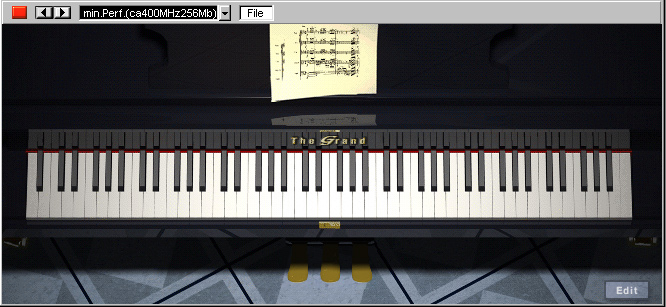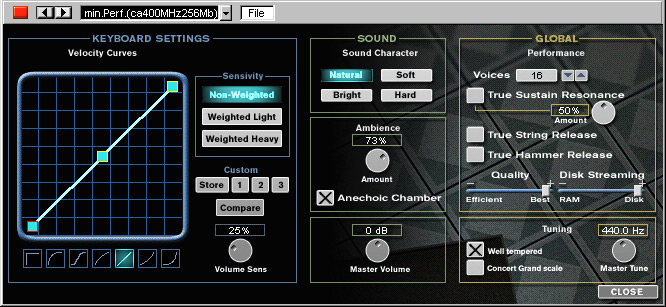The Grand

Before buying this plug-in, I was lucky enough to try it.
Installation : easy, but long, there are 3 CDs, and two of them have to be pasted on HD (more than 1 Go). The files are as usual installed in the VSTplugin folder.
At its first start, Cubase initializes the plug-in. When it is selected, we have to wait a little for it to be displayed.
In the small VST-instruments window, we have the choice between several programs, which concern the power we dispose. I chose the highest option: 512 MB / 1 GHz. Let?s go... first try...
The sound is very realistic, I will develop this aspect a bit further. The first screen we can see is the following :

When we click on the ?Edit? button, the following screen appears :

On the left part, we can adjust very precisely the dynamic response of the piano in relation to the sensitiveness of our keyboard (Yamaha S80 in my case). In the middle we can define :
- The characteristics of the sound : Natural, Soft, Bright or Hard
- The resonance of the room (reverb room)
- The volume.
On the right side is the most interesting part of the piano. We can modify the authenticity of the result, depending on the power which is allocated to the piano. If every option is selected, the sound will be more ?real? but it will use more resources.
The only option which is in my opinion not necessary is the ?True Hammer Release?. It is the sound of the hammer when the note is released. This noise can only be heard in pianissimo passages of a piano solo. On the other hand, the ?True String Release? seems to me really necessary. We can choose if the sound is loaded in the RAM or directly read on the HD. I didn?t notice important differences between RAM and Disk on my computer.
In the end, we can choose between a true or a well-tempered tuning, and tune the piano (general tuning only).
And now, the main part : the sound ! First, we have to notice that the quality of the sampling is nearly irreproachable. It is a very advised purchase for those who don?t have a piano that sounds real. For the others? It?s been a long time I am searching for a piano sound that would make me really excited. When Steinberg announced the release of The Grand, I have been disappointed in learning that it was a Kawai piano. I have never liked the sound of Kawai grand piano, and I have always preferred Yamaha, Steinway or Bösendorfer. When I began to play on The Grand, after having seen the Steinberg ads, I was waiting for the Graal. But no? This is an excellent piano, but we don?t have the same acoustic impression (when playing or listening) that we have when playing on a real piano in a studio with headphones.
I made several people listen the same sequence played with the Yamaha S80, the Kurzweil 2600 and The Grand. Opinions diverge, but people tend to prefer the K2600.
The price of The Grand is not comparable to these synthesizers or with a big sampler with sound banks, that?s why my personal verdict is the following: The Grand is necessary to those who don?t have one, at a very low cost (a powerful computer is nevertheless necessary). Those who already have good piano sounds have to listen to the sound to make an opinion. What is interesting is that we buy the sound of an instrument more than its performances.
As far as I am concerned, I brought The Grand back to my dealer. The quest of the Graal is not finished ,o)





